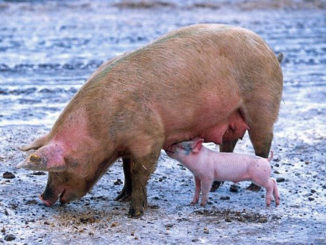African swine fever (ASF) is a trans-boundary, OIE listed viral disease of domestic and wild pigs belonging to family Suidae (all breeds and ages). It is also known as warthog disease and African pig disease. It is a highly contagious haemorrhagic viral disease responsible for serious economic and production losses in the livestock sector.
Epidemiology
African swine fever (ASF) was first discovered by Montgomery in Kenya in 1921, as a high mortality was seen among the pigs imported from Europe. It was thought to be due to a new disease which was observed in several Sub-Saharan countries. The disease was endemic to sub-Saharan Africa. The virus has its existence in the wild through a cycle of infection between ticks and wild pigs, bush pigs, and warthogs. Two distinct epidemiological patterns are recognized for the disease, a sylviatic cycle in warthogs in Africa and epidemic and endemic cycles in domestic swine.
The disease was reported for the first time outside Africa in Portugal, 1957 where an outbreak of ASF caused around 100% mortalities. The disease after a period of epidemiological silence reappeared in Portugal (1960) and there after the disease extended its existence to the whole of Iberian Peninsula very rapidly. Since then, ASF remained present in Spain and Portugal for more than twenty years, until it was finally eradicated in 1994 in Portugal and 1995 in Spain. Subsequently it was eradicated from many places except in the island of Sardinia, where the disease remains endemic since 1978. Currently, ASF is present in a large number of sub-Sahara African countries, the island of Sardinia (Italy), Caucasus countries and Russian Federation.
Recently in India, it is reported for the first time in Assam where the outbreak killed over 2,900 pigs since February 2020. It was reported both in domestic pigs and wild boars from Assam and Arunachal Pradesh.

Etiology
It is caused by a large, double-stranded DNA virus with linear genome belonging to Asfarviridae family called African swine fever virus (ASFV). Asfarvirus virions are enveloped, 175-215 nm in diameter, and have a complex icosahedral capsid, 180nm diameter. The genome of the virus is a single molecule of linear double-stranded DNA, 170-190 kbp in size having covalently closed ends with inverted terminal repeats and hairpin loops. Earlier it was classified under the family ‘Iridoviridae’ on the basis of its morphology but later on due to differences its mode of replication and structure of DNA, it was classified separately as the sole member of the family Asfarviridae.
It also infects ticks of the genus Ornithodoros. O. moubata and O. erraticus are seen as both reservoirs and transmission vectors of ASFV.
Mode of Transmission
Ticks being the biological vectors are considered as the primary means of maintaining the infection and spreading it to domestic pigs. The virus is present in the salivary glands of tick and it is passed to new hosts while it feeds on it. It can also be transmitted sexually between ticks, both transovarially to the eggs, or transtadially throughout the tick’s life. Wild warthogs and bush pigs are the asymptomatic carriers It is transmitted by direct contact with an infected pig (alive or dead), indirect contact through ingestion of contaminated material such as food waste, feed or garbage or through biological vectors such as ticks. As the virus may survive 11 days in pig faeces, and months or years in pork products, adequate bio security measures must be taken to prevent its spread.
Pathogenesis
The virus invades through respiratory tract and replicates in the pharyngeal tonsils and draining lymph node before the occurrence of generalized viremia which generally occurs 48-72 hours of infection. The virus is rapidly disseminated throughout the body via primary viremia in which the virions are associated with both erythrocytes and leukocytes. All the secretions and excretions of the organism contain amount of infectious virus. Experimentally it was demonstrated that the virus uses the reticuloendothelial system for multiplication and thus resulting in severe leukopenia. Death in infected animals is probably due to indirect effect of viral replication on platelets and complement functions rather than its direct cytolytic effect.
Clinical Signs
One of the typical findings of ASF is an acute haemorrhagic fever. The disease is characterized by high fever after an incubation period of about 5-15 days, persisting for about 4 days. After 1 to 2 days of fever, there is inappetence, diarrhoea, in coordination, prostration. In some cases, the swine may die at this stage without showing any other clinical signs, whereas in some cases there is dyspnoea, vomiting, discharge from nose and eyes reddening or cyanosis of ears and snout and haemorrhages from nose and anus; there may be abortion in pregnant animal. The case fatality rate (CFR) of the disease is about 100 percent.
Multiple strains of varying virulence exist among the pig population due to which the clinical signs and syndromes vary. Strain of high virulence is usually associated with sudden death with no signs of encephalitis, fever, prostration or skin alterations and has high mortality up to 90-100% with a clinical course of about 1-4 days. Typical signs of ASF that include prostration, lack of appetite, skin alterations, abortions and high mortality in mothers is due the virus strain of moderate virulence with a clinical course of about 7-20 days. Virus of low virulence is associated with the signs like multifocal cutaneous necrosis, painful inflammation of the carpus and tarsus and abortion and the total course is about 15-21 days.
The disease occurs in two forms, i.e acute and chronic. In its acute form, the disease begins with high fever. During this febrile period, the pigs appear well with good appetite. After 48 hrs, they become depressed, weak, and cyanotic; develop cough and dyspnoea and ultimately die. Signs such as vomition and diarrhoea may be observed and there may be haemorrhage from nose and anus. Pregnant sows may abort.
The course of the disease is prolonged in its chronic form and some pigs may recover or act as carrier. They remain persistently infected without even showing any signs and symptoms.
Lesions
Lesions are most prominent in lymphatic and vascular systems marked by widespread haemorrhages. Spleen is enlarged and friable, petechial haemorrhages in the cortex of kidney. Chronic form of the disease is characterized by ulcers, pneumonia, pericarditis, pleuritis and arthritis.
Diagnosis
It can be diagnosed in laboratory by isolating the virus by inoculation of pig leukocyte or bone marrow cultures. Fluorescent Antibody Technique (FAT) test can be performed for the detection of antigen (virus) in smears or cryostat sections of tissues. The molecular methods for detection of the viral genomic DNA include polymerase chain reaction (PCR) or real-time PCR, which are more efficient, specific, highly sensitive and rapid techniques for ASFV detection. They are especially useful when virus isolation and antigen detection are difficult.
Natural infection in pigs is usually associated with development of antibodies against ASFV from 7–10 days post-infection as a response of the host’s immune system to the viral antigen and these antibodies persist in the host’s system for long periods of time. In areas where the disease is endemic in occurrence, or it occurs in the form of a primary outbreak attributed to a strain of low or moderate virulence, new outbreaks in those areas can be investigated by detecting of specific antibodies to the virus in serum or extracts of the tissues collected. Antibody can be detected by methods such as the enzyme-linked immunosorbent assay (ELISA), the indirect fluorescent antibody test (IFAT), the indirect immunoperoxidase test (IPT), and the immunoblotting test (IBT).
Differential Diagnosis
African swine fever must be differentiated from Classical Swine Fever (CSF), whose signs may be similar to ASF, but is caused by a different virus which belongs to Flaviviriade family for which a vaccine exists. Coinciding signs like fever, depression and lesions like haemorrhages in the skin, kidney and lymphatic ganglia makes it very important to differentially diagnose the disease from CSF. In ASF, haemorrhages and oedema are more severe than CSF. Classical Swine Fever is differentiated as it has longer clinical course than ASF and it has characteristic lesions like button-shaped ulcers in the caecum and colon and splenic infarcts, pale renal parenchyma and non-purulent meningoencephalitis which is not there in ASF.
Other diseases like Swine Cholera, Erysipelas, acute Salmonellosis and Aujeszky’s disease, Porcine Dermatitis Nephropathy Syndrome must also be differentiated based on their typical features.
Prevention and Control
Implementation of appropriate import policies and bio security measures are essential steps for preventing an outbreak. It must be ensured that neither infected live pigs nor pork products are introduced into areas free of ASF. Proper disposal of waste materials and other sanitary and safety measures must be carried out if pigs are imported from affected countries and quarantine facilities must be taken care of.
Classic sanitary measures like appropriate diagnosis, monitoring through early detection in the swine herds, thorough cleansing and disinfection, isolation of the affected, symptomatic and carrier animals can be employed. Humane killing of animals with proper disposal of carcases and waste; zoning/compartmentalisation and movement controls facilities must be available. Surveillance and detailed epidemiological investigation are the key requisites for containing the disease in the long run. Control of insect vectors like ticks must be taken care of in order to control the disease outbreak. Last but not the least, supervision of the farm by a qualified veterinary officer is very important for timely and proper detection of the disease or any disease in the swine herds.
Currently there is no approved vaccine for ASF. Traditional approach for vaccine preparation involves killing or inactivating the pathogen by various means so they are not virulent but are immunogenic and results in production of protective antibodies, as these vaccines don’t activate killer T cells, so they don’t protect the pigs against intact forms of ASFV. Use of live vaccine can stimulate both antibody productions along with T cells activation without killing the vaccinated animal. Under this category comes both gene-deleted (genetically modifying the virulent forms of the virus by removal of sequences the code for lethal proteins) and naturally attenuated forms of ASFV.
Though till now scientists are unable to find a stable cell line for bulk production of live vaccine but these types of vaccine are expected to come up first in the market. Another type of approach is by genetically modifying viral vectors such as adenovirus so that it can express combination of ASFV antigens in the absence of pathogen.
ASF, even though it’s lethal, it is less infectious than many other livestock diseases. But as of now, there is no approved vaccine, which is also a reason why animals are culled to prevent the spread of infection.
Suggested Reading
- https://www.oie.int
- Veterinary Pathology by Ronald Duncan Hunt, Thomas Carlyle Jones and Norval W. King, 6th Edition (1 March 1997) Wiley-Blackwell.
- Jubb, Kennedy and Palmer’s Pathology of Domestic Animals, edited by Grant Maxie (2015) 6th Edition, Saunders Ltd.






Be the first to comment